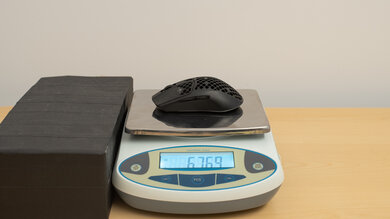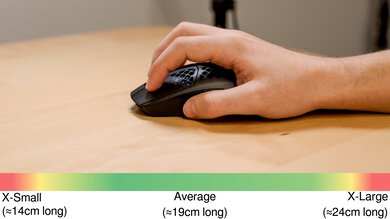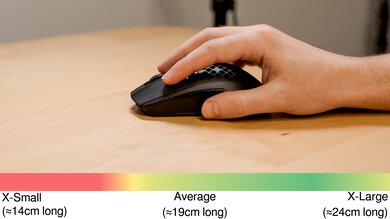The SteelSeries Aerox 3 Wireless is an excellent ultra-light gaming mouse. It has a honeycomb design that extends to the bottom of the mouse, making it amazingly lightweight. Its ambidextrous shape is comfortable to use for long periods and is better suited for a claw or fingertip grip. You can use it wirelessly through its USB dongle or via Bluetooth, and it lets you pair to two devices at the same time for multitasking. It has a low click latency and a high polling rate, resulting in a smooth and responsive gaming experience. The SteelSeries Engine 3 software has plenty of customization options; however, it isn't the most user-friendly and can be intimidating for first-time users. Also, you can only adjust the sensitivity setting in increments of 100 CPI, which might disappoint those who want greater control. On the upside, all the inputs are programmable, and it's fully compatible with Windows and macOS.
Our Verdict
The SteelSeries Aerox 3 Wireless is a good mouse for office use. You can connect it to your computer wirelessly via the USB dongle or through Bluetooth to keep your setup clean, and you can pair two devices at once for better multitasking. Its Engine 3 software lets you reprogram any of the inputs, and it's fully compatible with Windows and macOS. Unfortunately, the scroll wheel doesn't have L/R tilt inputs and can't be unlocked for infinite scrolling. The build quality is also only decent, as the body creaks and flexes a bit when applying pressure.
-
Comfortable to use.
-
Wireless connectivity.
-
Fully compatible with Windows and macOS.
-
Programmable inputs.
-
Bluetooth support.
-
Might not fit in some laptop cases.
-
No infinite scrolling or L/R tilt inputs.
-
Plastic creaks and flexes slightly.
The SteelSeries Aerox 3 Wireless is great for FPS games. It's light and wireless so that you can move freely, and gaming feels smooth and responsive thanks to its low click latency and high polling rate. Unfortunately, you can only adjust the sensitivity in increments of 100 CPI, which might disappoint serious gamers who want to fine-tune the performance settings. The build quality is decent, but there's some creaking and flexing when pressing hard on the plastic body.
-
Very lightweight.
-
Comfortable to use.
-
Low click latency.
-
High polling rate.
-
Bluetooth support.
-
Might not fit in some laptop cases.
-
Plastic creaks and flexes slightly.
-
Sensitivity adjustment in increments of 100 CPI.
The SteelSeries Aerox 3 Wireless is good for MMO games. It's reasonably comfortable to use for long periods, great for those hours-long raids. It has low click latency and a high polling rate to provide a responsive gaming experience. However, although all the inputs are programmable, it might not have enough buttons for some MMO players. Also, the plastic body flexes and creaks a bit when pressing on it.
-
Comfortable to use.
-
Low click latency.
-
High polling rate.
-
Programmable inputs.
-
Bluetooth support.
-
Might not have enough buttons for some MMO players.
-
Might not fit in some laptop cases.
-
Plastic creaks and flexes slightly.
-
Sensitivity adjustment in increments of 100 CPI.
-
Comfortable to use.
-
Bluetooth support.
-
Might not fit in some laptop cases.
-
Plastic creaks and flexes slightly.
- 6.4 Work
- 8.2 Video Games (FPS)
- 7.3 Video Games (MMO)
- 8.6 Raw Performance
Changelog
- Updated Mar 01, 2023: We've converted this review to Test Bench 1.4. This update modifies our Hand Size Recommendation test, adding a more granular hand size recommendation chart. We've moved several minor tests into different test groups, removed the Travel usage, and added a new Raw Performance usage. For more details, you can see our full changelog here.
- Updated Feb 02, 2023: We've added mention of the newly-reviewed Pulsar X2 Wireless in the Style section of this review.
- Updated Sep 16, 2022: We've converted this review to Test Bench 1.3. This update adds a new Sensor Latency test and makes minor changes to several of our existing tests, resulting in test result changes in several sections. For more information, you can check out our full changelog here.
- Updated Aug 17, 2022: We've converted this review to Test Bench 1.2. This update simplifies our Weight test and expands on our CPI test from Test Bench 1.1, resulting in changes to test results in both sections. For more details, you can see our complete changelog here.
- Updated Aug 16, 2022: We've converted this review to Test Bench 1.1. This update revamps our Click Latency test and results in changes to test results. For more details, you can see our full changelog here.
Check Price
Differences Between Sizes And Variants
We tested the SteelSeries Aerox 3 Wireless. It only comes in black, and there's a wired version as well, the SteelSeries Aerox 3. You can see our unit's label here.
Compared To Other Mice
The SteelSeries Aerox 3 Wireless is an excellent ultra-light gaming mouse. It's one of the the lightest wireless mice that we've tested, but it doesn't feel as well-built as other similar mice. For more options, check out our recommendations for the best wireless gaming mouse, the best gaming mouse, and the best wireless mouse.
The SteelSeries Aerox 3 Wireless and the GLORIOUS Model O Wireless are very much alike as they both have a lightweight honeycomb body, an ambidextrous shape, and a six-button layout. The GLORIOUS is marginally better due to its superior build quality and higher-quality PTFE feet. However, the SteelSeries has Bluetooth capability, multi-device pairing, and its Engine 3 software is compatible with macOS, which isn't the case with the GLORIOUS Core software.
Although the SteelSeries Aerox 3 Wireless and the Razer Viper Ultimate both have an ambidextrous design, only the Razer has thumb buttons on both sides. The Razer is better overall due to its superior build, higher-quality feet, and lower click latency. It also has more buttons and more programmable inputs due to its HyperShift feature. However, the SteelSeries' honeycomb body is lighter, it has multi-device pairing, and its Engine 4 software is compatible with macOS.
The SteelSeries Aerox 3 Wireless (2022) is the updated version of the SteelSeries Aerox 3 Wireless. Both mice have an ambidextrous shape with a honeycomb body to keep the weight down, and they both have excellent wireless connectivity options and connect with their USB receivers or over a Bluetooth connection. However, the 2022 edition features a more solid-feeling build with less flex in the body and higher-quality PTFE feet. It also has improved click latency.
The SteelSeries Aerox 3 Wireless and the SteelSeries Aerox 3 (2022) are very similar gaming mice. The Aerox 3 Wireless is a slightly older edition, so it doesn't have the same large, better-quality feet that the 2022 edition has, but you can use it wirelessly via its USB receiver or Bluetooth. Also, the Aerox 3 Wireless's sensor is better and offers a wider CPI range and a much lower lift-off distance. Both mice are advertised as rated at IP54, including all of their components, which is a high rating for a gaming mouse.
The SteelSeries Aerox 3 Wireless and the SteelSeries Aerox 5 Wireless are similar wireless gaming mice from the same lineup, but they're shaped differently and designed for playing different games. The Aerox 3 Wireless has a symmetrical shape and is slightly lighter, making it better-suited for FPS gaming. On the other hand, the Aerox 5 Wireless has a right-handed shape and more buttons, making it better suited for a variety of gaming genres.
The SteelSeries Aerox 3 is the wired version of the SteelSeries Aerox 3 Wireless; however, it has a different sensor than its wireless counterpart. The Wireless has a much wider CPI range, and its lower lift-off distance leads to fewer unintended movements when repositioning the mouse. Also, it's only slightly heavier than the wired version despite having an internal battery. Its wireless connectivity and multi-device pairing feature make it more ideal for office and portable use. The Wired has lower click latency and better build quality.
The SteelSeries Aerox 3 Wireless and the Cooler Master MM720 are both well-performing ultra-light gaming mice but with some differences. The SteelSeries has a more standard ambidextrous shape and supports a wireless connection and multi-device pairing. Its wireless connectivity also means you don't have to deal with cable drag while gaming. On the other hand, the Cooler Master is a wired mouse designed for right-handed use and has a much wider body thanks to its ring finger rest. That said, it has higher-quality feet and lower click latency, but its CPI variation is a bit high.
If you like honeycomb design, the SteelSeries Aerox 3 Wireless is a better gaming mouse than the SteelSeries Rival 650. The Aerox is designed for ultra-light gaming and is smaller and significantly lighter. It's well-suited for a claw grip or even a fingertip grip if you have medium to large hands. Performance-wise, it has a wider CPI range with less variation. That said, the Rival 650 feels quite a bit more solid, and its right-handed design is more comfortable, though it's not a good option for smaller hands. It also has one more side button.
Both the SteelSeries Aerox 3 Wireless and the Logitech G Pro Wireless have an ambidextrous shape, except that the Logitech is longer and taller, making it a better fit for large hands using a palm grip. The SteelSeries is a bit better because it's lighter, and its PTFE feet are of higher quality. However, the Logitech has lower click latency, and it allows you to adjust the sensitivity in smaller increments. Also, you can customize the Logitech to have the thumb buttons on the side that you prefer.
The SteelSeries Aerox 3 Wireless and the GLORIOUS Model O are very similar mice, as they're both ultra-light mice with a honeycomb body and an ambidextrous shape. However, the SteelSeries is better overall, mainly due to its wireless connectivity. This means you don't have to deal with cable drag, and you can connect it with two devices simultaneously. It's just as light as the GLORIOUS, and it has more programmable inputs because it lets you reprogram the wheel's up-and-down scroll. That said, the GLORIOUS feels better built, and it has higher-quality feet that provide a smoother glide. The GLORIOUS also has a longer body, making it more suitable for large hands using a palm grip.
The SteelSeries Aerox 3 Wireless and the G-Wolves Hati HT-M Classic Edition are very similar. They're both ultra-lightweight mice with an ambidextrous shape and honeycomb body, except the SteelSeries is wireless. The SteelSeries' wireless connectivity, multi-device pairing feature, and macOS compatibility make it better for productivity. The G-Wolves has a better build quality, and its longer body makes it more suitable for those with large hands using a palm grip.
The SteelSeries Aerox 3 Wireless is better than the Finalmouse Ultralight 2 - Cape Town for most uses. The SteelSeries is wireless and allows you to connect to two devices simultaneously for multitasking. Also, the SteelSeries is more customizable because it has software support for Windows and macOS, which the Finalmouse lacks. However, the Finalmouse has a better build quality, it's lighter, and its smaller size makes it better suited for small to medium-size hands regardless of grip type.
The SteelSeries Aerox 3 Wireless is better for several uses, but the Corsair SABRE PRO is a better gaming mouse, albeit with a wired-only connection. You can use the SteelSeries wired or wirelessly with the USB receiver or via Bluetooth, and you can wirelessly pair up to two devices. It also has RGB lighting and is suitable for all grip types. However, smaller hands will drape over the front using a palm grip and may not reach the scroll wheel using a fingertip grip. The Corsair has better click latency, a CPI that you can adjust by increments of one, and an 8000Hz maximum polling rate. It also feels sturdier and has a more flexible cable. It's suitable for all grip types, but those with smaller hands may have trouble reaching all buttons using a claw or fingertip grip.
Test Results
The SteelSeries Aerox 3 Wireless has almost the same shape as the SteelSeries Rival 3 but with a honeycomb body to reduce weight. It has RGB lighting along the bottom and inside the mouse, which you can customize through the Engine 3 software. The shape is ambidextrous, but it only has thumb buttons on the left side. For a similarly lightweight gaming mouse with heart and diamond-shaped cutouts instead of the exclusively rhombus-shaped cutouts on the SteelSeries, check out the Vancer BT.L Gretxa. Or, if you prefer a smaller gaming mouse with a solid plastic shell, check out the Pulsar X2.
The build quality is decent, with no wobbling or rattling; however, there's a little bit of squeaking and creaking when applying pressure. There's some flex on the bottom that shouldn't be noticeable in regular use, but the top flexes if you press hard enough, causing the CPI switching button to activate. The CPI switch button sometimes gets stuck on our unit, although your experience may vary. SteelSeries advertises an IP54 dust and water resistance, but this isn't something that we test. If you're interested in an ultra-light mouse that's only slightly heavier but has a better-feeling build quality, check out the Endgame Gear XM1r.
The SteelSeries Aerox 3 Wireless is very light and among the lightest wireless mice we've tested. However, there's no way to customize the weight to your preference. If you don't like the honeycomb design or want an even lighter mouse, check out the Logitech G PRO X SUPERLIGHT.
Like the SteelSeries Rival 3, the SteelSeries Aerox 3 Wireless has an ambidextrous shape, but it only has thumb buttons on the left side, making it more ideal for right-handed people. The side buttons are relatively large and well-placed. It's reasonably comfortable to use for an extended period and best suited for a claw or fingertip grip. There are no side grips or finger rests. If you'd prefer a wireless gaming mouse with an ergonomic right-handed shape, check out the ROCCAT Kone Pro Air or the GLORIOUS Model D Wireless.
You can connect the mouse to two devices simultaneously, one via the wireless USB-C dongle and the other over Bluetooth. It's usable while it's charging, and data is sent over the wired connection. There's an extension adapter included in the box to place the receiver closer in case your desktop is far enough to affect performance. If you don't have a USB-C port on your computer, you'll need to use the cable and the extension adapter since the cable has a USB-A plug on one end. SteelSeries advertises a 200-hour battery life; however, it isn't something that we test.
The cable is decent. It's a USB-A to USB-C cable that SteelSeries calls 'Super Mesh', and it feels like it's between a braided cable and a paracord-like cable. The flexibility is mediocre, and it retains kinks.
The PTFE feet are excellent. They provide a smooth glide on a cloth mouse pad or directly on the desk. At this time, we can't find any third-party replacement feet. The updated version of this mouse, the SteelSeries Aerox 3 Wireless (2022), has virgin-grade PTFE feet, if you're looking for a similar mouse with a better gliding experience.
The SteelSeries Aerox 3 Wireless has a decent number of buttons. Every button, including the scroll wheel's up and down scroll, are programmable. You can remap the left-click without first assigning it to another button, but because you no longer have access to a left-click, you need another mouse to set it back to the default. The SteelSeries Engine 3 software has a pop-up message that warns you before proceeding. For a similar mouse with hot-swappable left and right click switches, check out the ASUS ROG Strix Impact II Wireless.
The SteelSeries Aerox 3 Wireless has great click latency. It's a little higher than other wireless mice like the Razer DeathAdder V2 Pro, but it shouldn't be noticeable for most people.
The SteelSeries Aerox 3 Wireless uses an optical sensor with a wide CPI range, but you can only adjust the sensitivity in increments of 100 CPI, which might disappoint those who want more precision. You can set the polling rate to 125Hz, 250Hz, 500Hz, or 1000Hz. The sensor isn't exactly at the center; it's slightly below. Unlike the SteelSeries Aerox 3 (2022), a upgraded but wired version of this mouse, it has a very low lift off distance.
The SteelSeries Aerox 3 Wireless doesn't produce a lot of clicking noise and shouldn't bother those around you.
Update 01/31/2022: Initially, we'd mistakenly indicated you could save custom RGB settings to the onboard memory. We've updated the text with the correct information.
The SteelSeries Engine 3 software has an exceptional number of features; however, it isn't the easiest to use and can be a bit daunting for less tech-savvy people. It lets you adjust the performance settings, customize the RGB lighting, remap buttons, and create macros. You can save button assignments on the onboard memory, but not macros or lighting profiles.
Comments
SteelSeries Aerox 3 Wireless: Main Discussion
Let us know why you want us to review the product here, or encourage others to vote for this product.
































